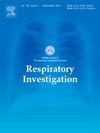Expanding the radiological spectrum of Lymphangioleiomyomatosis: A case with Unique imaging findings
IF 2.4
Q2 RESPIRATORY SYSTEM
引用次数: 0
Abstract
Lymphangioleiomyomatosis (LAM) is a rare cystic lung disease linked to tuberous sclerosis (TSC) gene mutations and female sex restriction. Pulmonary cysts on high-resolution computed tomography (HRCT) are its hallmark. We report an unusual LAM case with minimal cystic changes, diffuse ground-glass opacities, and randomly distributed nodules. Diagnosis was confirmed by histopathology and elevated serum VEGF-D levels. The patient responded well to sirolimus, later discontinuing it, completing pregnancy without exacerbation, and safely resuming therapy postpartum. This case underscores the diagnostic challenges of atypical LAM and highlights the importance of early diagnosis and individualized management in women of childbearing age.
扩大淋巴管平滑肌瘤病的放射谱:一个具有独特影像学表现的病例
淋巴管平滑肌瘤病(LAM)是一种罕见的囊性肺疾病,与结节性硬化症(TSC)基因突变和女性性别限制有关。高分辨率计算机断层扫描(HRCT)显示肺囊肿是其标志。我们报告一例罕见的LAM病例,其表现为微小的囊性改变,弥漫性磨玻璃样混浊,以及随机分布的结节。组织病理学和血清VEGF-D水平升高证实了诊断。患者对西罗莫司反应良好,后来停药,完成妊娠无加重,并安全恢复产后治疗。本病例强调了非典型LAM的诊断挑战,并强调了育龄妇女早期诊断和个性化管理的重要性。
本文章由计算机程序翻译,如有差异,请以英文原文为准。
求助全文
约1分钟内获得全文
求助全文

 求助内容:
求助内容: 应助结果提醒方式:
应助结果提醒方式:


